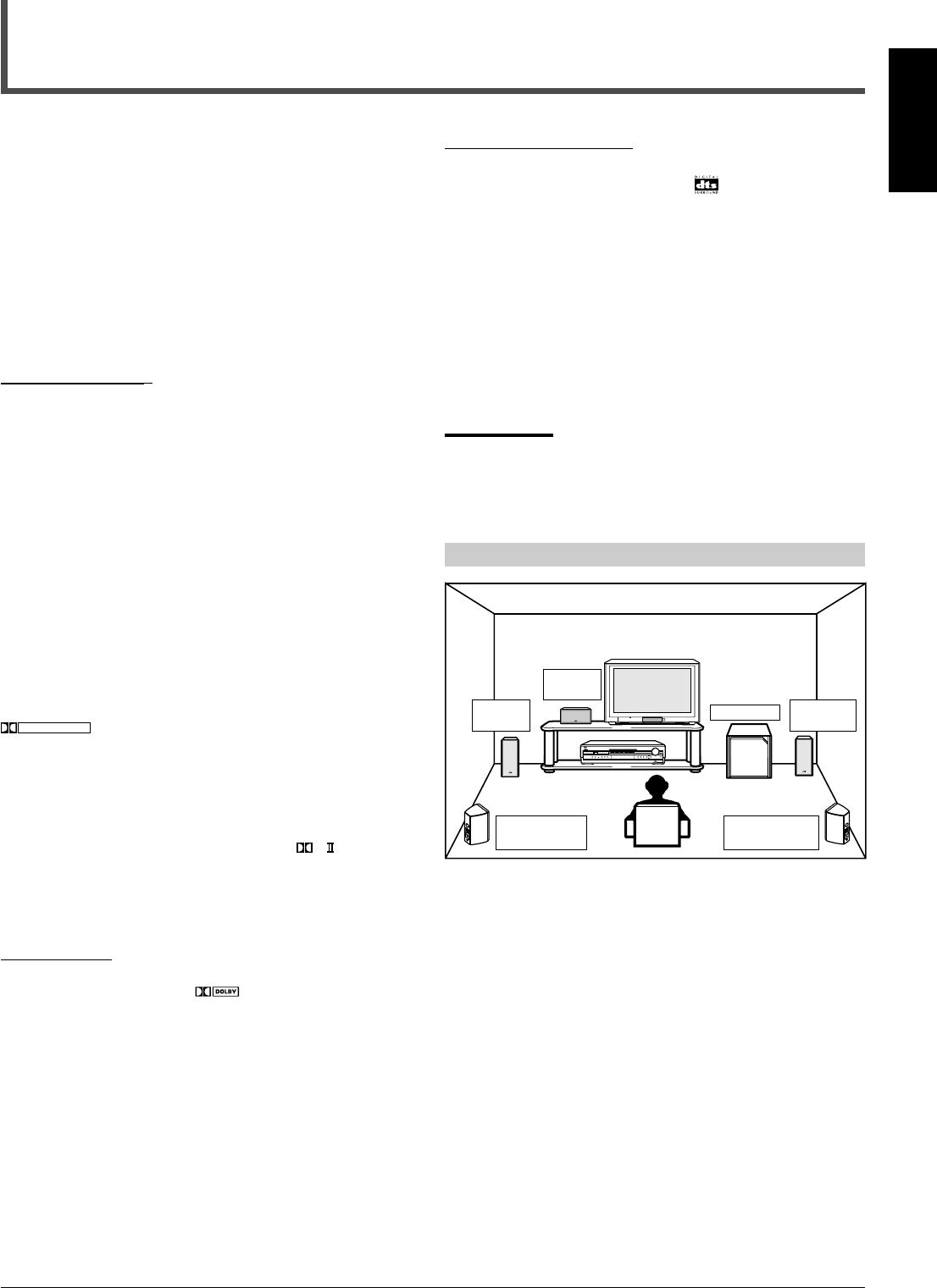
28
English
**
“DTS” and “DTS Digital Surround” are registered trademarks of
Digital Theater Systems, Inc.
*
Manufactured under license from Dolby Laboratories. “Dolby”, “Pro
Logic”, and the double-D symbol are trademarks of Dolby
Laboratories.
Creating Realistic Sound Fields
You can use the following Surround modes to reproduce a
realistic sound field:
7 Dolby surround
• Dolby Pro Logic II
7 Digital multi-channel surround
• Dolby Digital
• DTS Digital Surround
7 DAP (Digital Acoustic Processor) modes
7 All Channel Stereo
■ Dolby surround
Dolby Pro Logic II*
Dolby Pro Logic II is a playback format to decode into 5.1-
channel from all 2-channel sources—stereo sources and
Dolby surround encoded sources.
Matrix-based encoding/decoding method for Dolby Pro Logic
II makes no limitation for the cutoff frequency of the surround
treble and enables stereo surround sound compared to
conventional Dolby Pro Logic.
• You cannot select Dolby Pro Logic II when playing back
DVD AUDIO.
Dolby Pro Logic II enables you to reproduce spacious sound
from original sound without adding any new sounds and tonal
colorations.
Dolby Pro Logic II has two modes—Movie mode and Music
mode:
Pro Logic II Movie (PLII MOVIE)—suitable for reproduction
of Dolby Surround encoded sources bearing the mark
DOLBY SURROUND
and stereo television sources. You can enjoy a
sound field very close to the one created with discrete 5.1-
channel sounds.
Pro Logic II Music (PLII MUSIC)—suitable for reproduction
of any 2-channel stereo music sources. You can enjoy wide
and deep sound by using this mode.
• When Dolby Pro Logic II is activated, the
PL
indicator
lights up on the display.
■ Digital multi-channel (5.1 channel) surround
Dolby Digital*
Used to reproduce multi-channel sound tracks of the software
encoded with Dolby Digital (
DIGITAL
).
• To enjoy the software encoded with Dolby Digital, connect
the source component using the digital terminal on the rear
of this unit. (See page 11.)
Dolby Digital 5.1-channel encoding method (so-called
discrete multi-channel digital audio format) records and
digitally compresses the left front channel, right front channel,
center channel, left surround channel, right surround
channel, and LFE channel signals.
Since each channel is completely independent from the other
channel signals to avoid interference, you can obtain much
better sound quality with many stereo and surround effects.
Subwoofer
Left front
speaker
Right surround
speaker
Left surround
speaker
Center
speaker
Right front
speaker
MASTER VOLUME
DVD/SUPER VCD/VCD/CD
DVD AUDIO
INPUT ATT. REC MODE
INPUT
ANALOG/DIGITAL
COMPACT
SUPER VIDEO
DIGITAL
SURROUND
SETTINGADJUSTMEMORY
RX-DV31 HOME THEATER DVD-AUDIO/VIDEO RECEIVER
ON/OFF
SURROUND
MODE
FM/AMTAPE/CDR
SOURCE NAME
TVVCRDBSDV D
CONTROL
STANDBY
STANDBY/ON
DTS Digital Surround**
Used to reproduce multi-channel sound tracks of software
encoded with DTS Digital Surround (
).
• To use software encoded with DTS Digital Surround,
connect the source component using the digital terminal on
the rear of this unit. (See page 11.)
DTS Digital Surround is another discrete multi-channel
digital audio format available on CD, LD, and DVD software.
Compared to Dolby Digital, audio compression ratio is
relatively low. This fact allows DTS Digital Surround format to
add breadth and depth to the reproduced sounds. As a
result, DTS Digital Surround features natural, solid and clear
sound.
Note:
• Dolby Digital or DTS software can be roughly grouped into two
categories—multi-channel (up to 5.1-channel) and 2-channel
software. To enjoy surround sounds while playing Dolby Digital 2-
channel or DTS software, you can use Dolby Pro Logic II.
Typical multi-channel (5.1-channel) reproduction
■ DAP (Digital Acoustic Processor) modes
DAP modes have been designed to create important
acoustic surround elements.
• You cannot select DAP modes when playing back DVD
AUDIO.
The sound heard in a live club, dance club, hall or pavilion
consists of direct sound and indirect sound—early reflections
and reflections from behind. Direct sounds reach the listener
directly without any reflection. On the other hand, indirect
sounds are delayed by the distances of the ceiling and walls
(see the diagram on the next page).
These indirect sounds are important elements of the acoustic
surround effects. The DAP mode can reproduce a realistic
sound field by adding these indirect sounds.
28-31_RX-DV31SL[C]f.p65 03.12.18, 15:0828


















